Rise and Fall
page 1
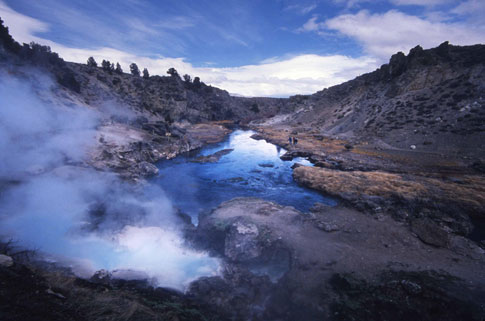
Mono Lake and the Fate of the People Who Fought The West's Pivotal Water Battle
In water terms, one must call it a confluence — people, resources, nature, money, power, and the limits of water exploitation in a dry land — all swept together in high stakes battle centered on the fate of a single unique place: Mono Lake.
Mono Basin water is the farthest reach of the country's most successful water pirate: the City of Los Angeles. First, it is quite literally the farthest reach: the Lee Vining intake pulls in water from the northernmost point on the 361-mile Los Angeles aqueduct. But secondly and more importantly, as court proceedings determined, Mono Lake also proved to be the end point of western water rights claims. In fact, the Mono Lake case upended water case law in a startling and precedent-setting way.
In 1941, the Los Angeles Department of Water and Power began diverting tributary streams to meet the growing water demands of Los Angeles. Deprived of its freshwater sources, the volume of Mono Lake halved, while its salinity doubled. The huge lake fell more than 40 vertical feet. Vast areas of lakebed were reduced to bleached saltflats. Islands that had previously been crucial nesting sites for a host of species became peninsulas vulnerable to predation. Stream ecosystems unraveled due to lack of water. The entire lake ecosystem began to falter and collapse.
page 2
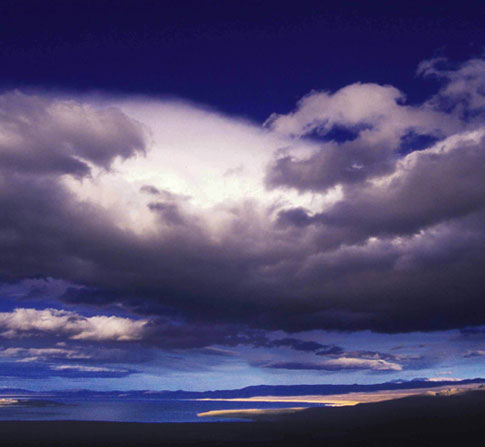
Then came the Mono Lake decision. Historian John Hart calls it "a judicial earthquake." Before Mono Lake, water rights were regarded as the functional equivalent of private property, embedded in tradition and the law. The private owners of water could do whatever they wished with it, regardless of ecological damage or the needs of others or the environment.
page 3
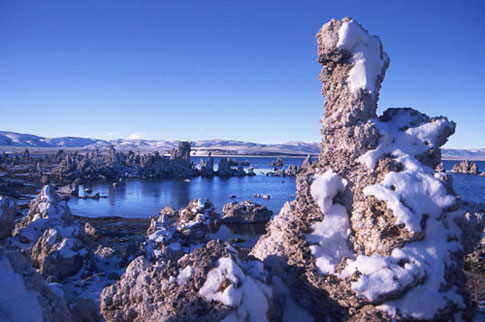
After Mono Lake, the principle jus publicum triumphed — some resources are so precious that they defy private ownership, belonging instead to everyone. This is known as the Public Trust Doctrine. The remarkable ruling established that the ecological health of certain places — in this case the Mono Lake basin and ecosystem — belong to the public. And the public trust trumps all prior claims, even water rights.
The ruling was almost too late for Mono Lake, then well on the way to becoming a lifeless chemical sump. Instead, the ruling required the Los Angeles Department of Water and Power to stop taking water from the basin until the lake regained a healthy level. It required renewal and restoration. It revoked well-established water rights.
The Mono Lake ruling was so powerful and decisive that it was not appealed. The new and remarkable precedent of "public trust" stands today and has changed the course of environmental law.
Mono Lake and Me
By chance, I had a complex multi-year involvement in the long legal and media struggle over Mono Lake. I dealt directly with many of the key players in the legal battle: lawyers and advocates, scientists and strategists. I spent a great deal of time in the Mono Basin and Owens Valley. I made thousands of photographs, many of which became part of the official case submissions to the California State Water Resources Control Board.
page 4
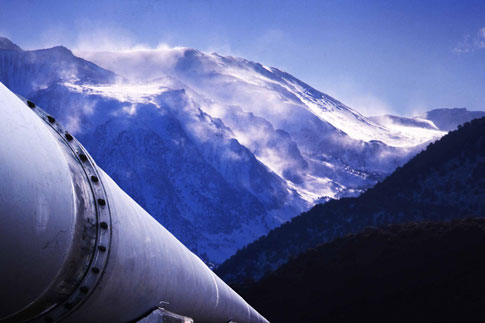
I photographed the lowered lake, the salt build-up as the salinity climbed, the islands become peninsulas, the coyote tracks heading toward the exposed nesting birds. I shot the winter snow piled against tufa towers exposed by the low water. I flew to Sacramento and photographed the expert witnesses in the case. I tracked down and rephotographed precise spots matching images made in 1939 before the diversions began. I made panoramas from highpoints on the Sierra's eastern edge, and slides of the winter snowmelt feeding the lake. I photographed the intakes on Lee Vining and Rush Creeks, and the massive steel penstocks carrying the water 400 miles south to Los Angeles.
But I have a deeper connection to Mono Lake. Every year of my childhood from as early as I can remember, the family trekked up Highway 395. My father is a geologist, and he did his Ph.D thesis on the geology of the White Mountains — the high range known for the Bristlecone Pine that encloses the east side of the Owens Valley.
page 5
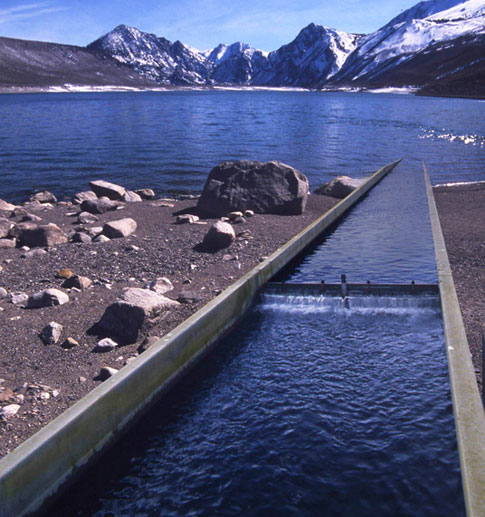
So every summer without fail, the family roamed the Owens Valley, the Bishop Grade, the Mono Basin, Lee Vining Pass, and the Yosemite High Country. I've been on the back trails of the Alabama Hills, flyfished on the hidden remaining fragments of the Owens River, and camped in remote Saline Valley, the deepest valley on the continent. I've climbed to the top of Mono Basin's Panum Crater where the pumice boulders are so light and frothy you can grab one the size of a refrigerator and toss it twenty feet. I've visited the lava flow where Native Americans quarried the prized brown-tinged, fine-grained Mono Basin obsidian that archeologists find traded across the entire west. Mono Basin lives in my soul.
page 6
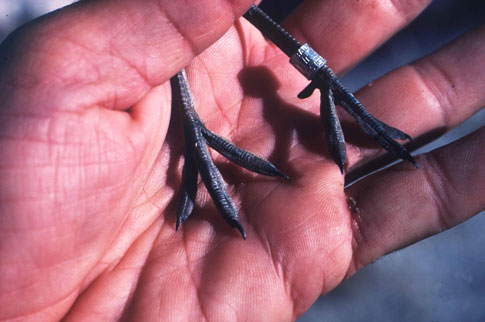
We Change Mono Lake And the Lake Changes Us
The Mono Lake court case is its own socio-ecosystem, one that stirs together power, people, water and fate. It intermixes and mingles them in a way that can never be undone. This is based on a simple but powerful idea. We are part of nature, just one strand in the web. We affect the lake and the lake affects us.
The Mono Lake case changed environmental law, but it also changed the people who waged a legal fight that culminated nearly fifteen years ago. And from change comes art.
There is strange poetry art in how lives and the lake have been shaped, flows diverted and redirected, paths altered, balances changed, by the epic struggle over Mono Lake. The court case itself is complex, delicately balanced, and ultimately mysterious ecosystem. It is art.
Some Inhabitants of the Mono Lake Ecosystem
Sally Gaines
As an undergraduate in 1976, Sally Gaines worked on the first ecological study of Mono Lake. From that moment forward she has been held in the orbit of the lake. She co-founded the Mono Lake Committee with her future husband David. When he was killed in a mid-winter car accident on Highway 395, Sally was left with their children Vireo and Sage, ages two-and-a-half and five, and the battle over the lake. The children are now in college, and she remains board chair of the Mono Lake Committee.
Mitch Kodama
In his position as a chief engineer for the Los Angeles Department of Water and Power, Mitch Kodama led the department's twenty year legal fight to retain their water rights and water diversions in the Mono Basin. But as the final hearings approached, Kodama became convinced that the ecological health of the lake was crucial. At considerable risk to his career, he championed this position on the upper floors of the DWP building in downtown Los Angeles. Kodama is now retired and lives in Hacienda Heights east of L.A.
page 7
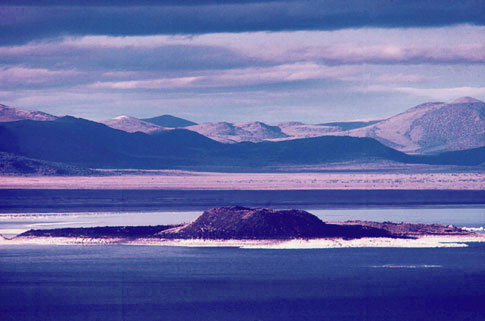
Tom Birmingham
Lead attorney and top strategist for the Los Angeles Department of Water and Power, Tom Birmingham presided over the greatest legal defeat in recent environmental law. Birmingham ceased law practice and is now the general manager of Westlands Water District. Westlands supplies water to nearly 1,000 square miles of industrial farmland in the California Central Valley.
Virginia Cahill
Representing the United States Department of Fish and Game, Virginia Cahill was the voice for endangered species during the culmination of the Mono Lake legal proceedings. She is now a professor at UC Davis in the Department of Land, Air, and Water Resources.
Larry Silver
Longtime attorney and activist for the Sierra Club, Larry Silver represented not just his organization, but a broad coalition of groups who coalesced around the Mono Lake issue in the earliest days of the modern environmental movement. In 2003, Silver took a job as name partner and head of the environmental law practice at the Philadelphia-based firm Langsam, Stevens & Silver.
Bruce Dodge
As a young lawyer in 1978 at the San Francisco firm Morrison and Foerster, Bruce Dodge persuaded his firm to begin pro bono work for a fledgling organization called the Mono Lake Committee. Dodge has been the Committee's lead attorney for thirty years now, involved in every twist and turn of the effort. At the culminating proceedings, he represented both the Committee and the National Audubon Society.
Dan Frink
Operating behind the scenes as Chief Counsel to the California State Water Resources Control Board, Dan Frink is reputed to have crafted and then sold to the board the ultimate ruling overturning LADWP's longheld water rights and preserving the Mono Lake ecosystem. Frink is still a power at the SWRCB, now holding the position of Senior Staff Counsel.
John Melack
A worldwide authority on the ecology of saline lakes, John Melack has spent 30 years studying Mono Lake. He was central to the first unbiased study of the lake ecosystem, commissioned by Congress in 1984 and funded by the National Academy of Sciences. As a paid expert witness for the Los Angeles Department of Water and Power, Melack walked a line between impartiality and advocacy. He is now a professor at the University of California, Santa Barbara.
RELATED PLACES mono lake



